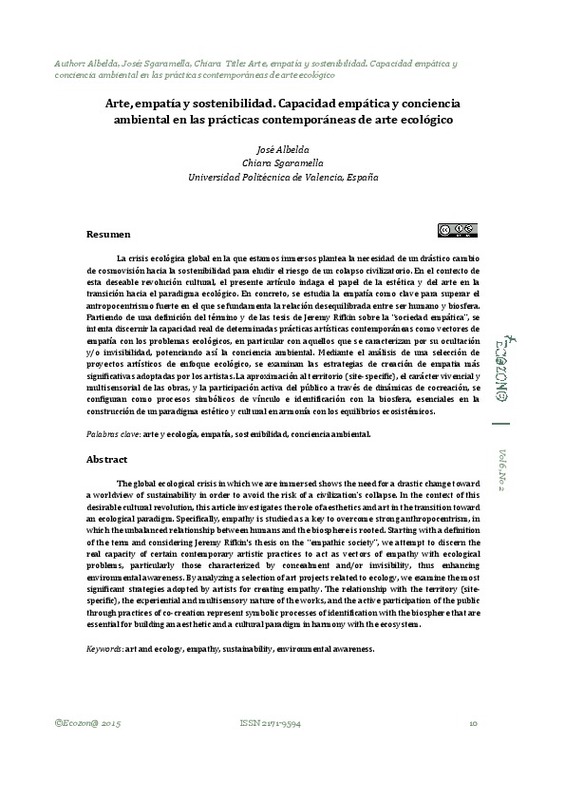|
Resumen:
|
[EN] The global ecological crisis in which we are immersed shows the need for a drastic change toward a worldview of sustainability in order to avoid the risk of a civilization’s collapse. In the context of this desirable ...[+]
[EN] The global ecological crisis in which we are immersed shows the need for a drastic change toward a worldview of sustainability in order to avoid the risk of a civilization’s collapse. In the context of this desirable culturalrevolution, this article investigates the role of aesthetics and art in the transition toward an ecological paradigm. Specifically, empathy is studied as a key to overcome strong anthropocentrism, in which the unbalanced relationship between humans and the biosphere is rooted. Starting with a definition of the term and considering Jeremy Rifkin's thesis on the
“empathic society”, we attempt to discern the real capacity of certain contemporary artistic practices to act as vectors of empathy with ecological problems, particularly those characterized by concealment and/or invisibility, thus enhancing environmental awareness. By analyzing a selection of art projects related to ecology, we examine the most significant strategies adopted by artists for creating empathy. The relationship with the territory (site
-specific), the experiential and multisensory nature of the works, and the active participation of the public through practices of co-creation represent symbolic processes of identification with the biosphere that are essential for building an aesthetic and a cultural paradigm in harmony with the ecosystem.
[-]
[ES] La crisis ecológica global en la que estamos inmersos plantea la necesidad de un drástico cambio de cosmovisión hacia la sostenibilidad para eludir el riesgo de un colapso civilizatorio. En el contexto de esta deseable ...[+]
[ES] La crisis ecológica global en la que estamos inmersos plantea la necesidad de un drástico cambio de cosmovisión hacia la sostenibilidad para eludir el riesgo de un colapso civilizatorio. En el contexto de esta deseable revolución cultural, el presente artículo indaga el papel de la estética y del arte en la transición hacia el paradigma ecológico. En concreto, se estudia la empatía como clave para superar el antropocentrismo fuerte en el que se fundamenta la relación desequilibrada entre ser humano y biosfera. Partiendo de una definición del término y de las tesis de Jeremy Rifkin sobre la sociedad empática , se intenta discernir la capacidad real de determinadas prácticas artísticas contemporáneas como vectores de empatía con los problemas ecológicos, en particular con aquellos que se caracterizan por su ocultación y/o invisibilidad, potenciando así la conciencia ambiental. Mediante el análisis de una selección de proyectos artísticos de enfoque ecológico, se examinan las estrategias de creación de empatia más significativas adoptadas por los artistas. La aproximación al territorio (site-specific), el carácter vivencial y multisensorial de las obras, y la participación activa del público a través de dinámicas de cocreación, se configuran como procesos simbólicos de vínculo e identificación con la biosfera, esenciales en la construcción de un paradigma estético y cultural en armonía con los equilibrios ecosistémicos.
[-]
|







